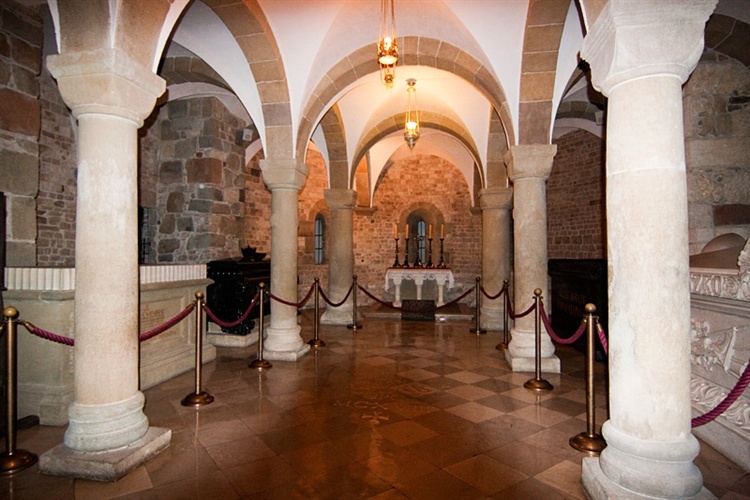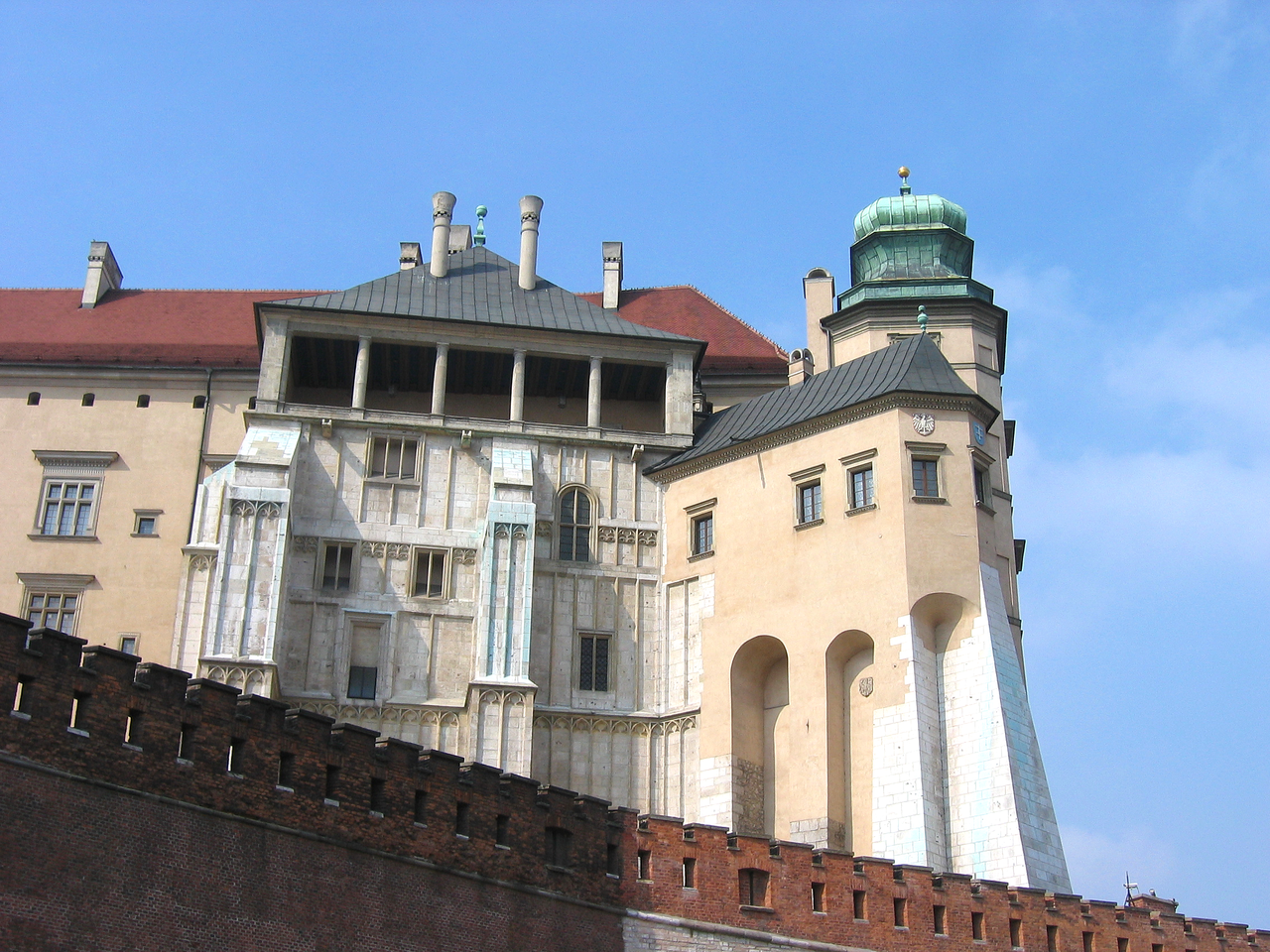 Zamek – Wawel – Komnaty królewskie
Zamek – Wawel – Komnaty królewskie
Stanowią one odrębny etap zwiedzania zamku wawelskiego, tym razem rozpoczynający się od wejścia we wschodniej ścianie dziedzińca (od bramy – na prawo po skosie).
Na I piętrze, częściowo zamkniętym dla zwiedzających, upływało intymne życie królewskich rodzin i świty dworskiej. W zachodnim skrzydle mieszkała królowa i jej damy dworu, w północnym mieściły się pokoje reprezentacyjne i gabinety króla, wschodnie zaś skrzydło zajmował król i dworzanie. Wśród sal I piętra najsłynniejsze to: sala w „Kurzej Stopce”, gdzie urzędowała królowa Jadwiga (obok znajdowała się toaleta królewska), sypialnia Zygmunta Starego, a także pracownia alchemiczna, w której Zygmunt III Waza próbował wynaleźć kamień filozoficzny i przy okazji wywołał pożar zamku w 1595 r. Piętro II, zwane piano nobile, służyło celom reprezentacyjnym. W salach dziś udostępnianych do zwiedzania przyjmowano posłów, urządzano uczty i narady.
Na I piętrze do zwiedzania udostępniono trzy komnaty z apartamentu królewskiego. W sali I zobaczysz arrasy z motywami roślinnymi (tzw. werdiury), meble renesansowe oraz obrazy z XVI w.:
– Caritas (Jan Massys);
– Portret młodzieńca (Łukasz Cranach);
– Św. Rodzina (Jan van Hemessen);
– Lot z córkami (Georg Pencz);
– Lukrecja (szkoła francuska);
– Scena z Achillesem (Jan Cossaert).
W sali II. poza dalszą częścią arrasów, wystawano dwie włoskie rzeźby z XVI w. (św. Jan Chrzciciel św. Sebastian).
W sali III oglądamy meble włoskie i arrasy z groteskami. Ponadto obrazy:
– Hołd trzech króli (szk. antwerpska, XVI w.);
– Alegoria losu szczęśliwego (Frans Francken II);
– Ecce homo (szk. antwerpska);
– Matka Boska z Dzieciątkiem (krąg Botticellego);
– Sąd Ostateczny (naśladowca Hieronima Boscha);
– Vanitas (Bartolomaus Sprenger).
Zwiedzanie zaczyna się od parteru. W pierwszej sali wiszą trzy gobeliny z XVII w. Dwa po lewej z serii Wojna Trojańska przedstawiają Achillesa z Agamemnonem oraz Priama witającego Helenę. Po prawej można podziwiać arrasowe Dzieje Celadona i Astrei. Jak widać, wnętrza wawelskie nie są muzeum gablotowym. Urządzono je tak, aby choć w części oddawały dawny wystrój, a także gust Jagiellonów i Wazów. Fakt, że komnaty nie są przeładowane, urządzono je bowiem z powściągliwością i umiarem, wynika z faktu, iż lwia część skradzionego lub zastawionego wyposażenia ozdabia całkiem inne wnętrza. Mimo wysiłków organizatorów i niezaprzeczalnej wartości obrazów, mebli i arrasów, trudno poczuć się w komnatach tak, jakby przed chwilą opuścił je Zygmunt Stary, prowadząc pod rękę swoją włoską małżonkę.
Wyposażenie dwu następnych komnat, które zamieszkiwał wielkorządca, próbuje nawiązać do dawnego wyglądu – jest tu gobelin przedstawiający Marsa, z serii Bogowie Planet, pochodzący z Flandrii z XVI w. i wielkie XVI-wieczne łoże angielskie z baldachimem. W kolejnym pomieszczeniu stoją polskie skrzynie do przechowywania pieniędzy, a na ścianach wiszą trzy obrazy: Wenus z Amorem (szkoła niderlandzka, XVI-XVII w.), portret błazna (Jan Miense Molaener, XVII w.) i Pożar Troi (Gillis van Valckenborgh, ok. 1600 r.).
Przez Sień Poselską wchodzi się najpierw na I piętro, gdzie można oglądać dawne apartamenty mieszkalne. W sieni na wysokości I piętra w kolejności wzrok przyciągają: obraz Józef tłumaczący sny (Antonio Zanchi, XVII w.), dwa marmurowe popiersia cesarzy rzymskich – Karakalli i Oktawiana Augusta, brukselski gobelin z XVII w. przedstawiający śmierć Rzymianina Decjusza Musa. Warto zatrzymać się na dłużej przed cennym pod względem historycznym obrazem (malarz nieznany), którego tematem jest elekcja Augusta III Sasa, oraz dziełem Jana van Noorta z 1654 r. – portretem chłopca w hiszpańskim stroju. Sień Poselską na II piętrze zapełniają: brukselski gobelin z ok. 1700 r. z cyklu Dwanaście miesięcy; kolejne dwa popiersia rzymskie; dwa portrety – mężczyzny (Govert Flinck, 1637 r.) i księcia orańskiego (prawdopodobnie Gerard van Honthorst, XVI w.). Ciąg sal reprezentacyjnych II piętra otwiera Sala Turniejowa, której nazwa pochodzi od fryzu wyobrażającego turniej rycerski, namalowanego przez Hansa Diirera i Antoniego z Wrocławia.
Następna sala – Pod Przeglądem Wojsk – dawna sień przed Salą Poselską, zawdzięcza swoją nazwę fryzowi Antoniego z Wrocławia z 1535 r., przedstawiającemu wojska defilujące przed królem Zygmuntem Starym. Ściany zdobią cztery arrasy opatrzone monogramem SA (Sigismundus Augustus), przedstawiające groteskowe sceny. To tylko zapowiedź wspanialej kolekcji drogocennych gobelinów, które rozwieszono i w innych komnatach zamku.







